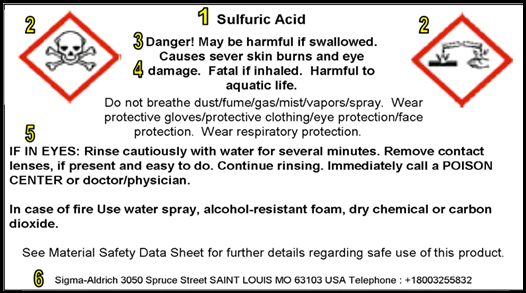
Environmental Health and Safety
Globally Harmonized System (GHS)
WISHA has revised its Hazard Communication Standard to align it with the United Nations’ Globally Harmonized System of Classification and Labeling of Chemicals (GHS). This revision of the Hazard Communication Standard includes two significant changes: (1) new labeling elements and (2) a standardized format for Safety Data Sheets (SDSs), formally known as Material Safety Data Sheets.
Labels

- Product Identifier - Identifies the substance by name or number
- Pictograms - Convey specific information about the hazard of a substance
- Signal Word - Alerts users on the severity of hazard "Danger" or "Warning"
- Hazard Statements - Describe the nature of the hazards of a substance
- Precautionary Statements - Describe recommended measures that should be taken to minimize or prevent adverse effects resulting from exposure to the substance or improper storage/handling
- Supplier Information - Name, address, and telephone number of the manufacturer, distributor, or importer
Pictograms

Explosives. Self-reactives, Organic
peroxides

Flammables, Self- reactives, Pyrophorics, Self-
heating

Oxidizers

Gas under pressure

Carcinogen, Reproductive/Target organ toxicity,
Mutagenicity

Acute toxicity (severe)

Environmental toxicity

Irritant, sensitizer, Acute toxicity, Respiratory tract
irritation

Corrosive
Safety Data Sheets (SDS)
Manufacturer, distributors, and importers are required to provide Safety Data Sheets (SDSs), formerly known as Material Safety Data Sheets (MSDSs), to communicate the hazards of hazardous substances. The WISHA revision of the Hazard Communication Standard requires SDSs to follow a standardized 16-section format.
- Identification
- Hazard(s) Identification
- Composition/Information on Ingredients
- First-aid Measures
- Fire-fighting Measures
- Accidental Release Measures
- Handling and Storage
- Exposure Controls/Personal Protection
- Physical and Chemical Properties
- Stability and Reactivity
- Toxicological Information
- Ecological Information
- Disposal Considerations
- Transport Information
- Regulatory Information
- Other Information
CWU News

Online Master’s of Education program now offers special education endorsement
May 15, 2024
by Rune Torgersen

Lenny Price brings Detroit perspective to CWU Jazz
May 15, 2024
by University Relations